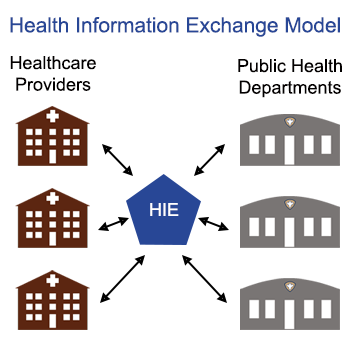Posted By Monique Dever On February 14, 2017
Is the value of participating in Health Information Exchange (HIE) worth it for public health departments?

Is it critical for a public health department to connect to a health information exchange (HIE)?
Over the past several years, the answer to this question has been a confused “I don’t know enough about HIEs to know.” So, what has changed? For one, EHRs, which not only compile data, but also can standardize data fields, are being implemented nationwide. For another, the Centers for Medicare and Medicaid Services (CMS) Meaningful Use Stage 3 will mandate a certain amount of data exchange between healthcare facilities in order to receive incentive payments.
In a previous blog, “Four Ways to Exchange Data with Community Providers,” we outlined four basic methods for exchanging data. This was to help local health departments determine if HIE was the best solution for their needs. If you decided that yes, HIE is the way to go, than you need to know more about HIEs. Which type of HIE should you use and how will you use it?
If you are still in the camp of confusion, probably the best place to start is the Healthcare Information and Management Systems Society (HIMSS) website. There are various types of HIEs; which type is best for you will depend on many factors, so health departments should dig deep into each option.
HIE organizations (HIOs) vary from state to state and all have many similar offerings. In addition to having the required security for data sharing, there are two ways to use HIOs: pulling patient information from other locations, such as an emergency room doctor pulling health information (e.g. allergies) of a newly admitted patient, or by pushing information out to another healthcare provider, such as delivery of clinical results (e.g. labs). Common use cases for public health departments are vast, for example reporting vaccines administered to immunization registries, sharing prenatal records with hospitals, or Syndromic surveillance of emergency department visits and hospitalizations. While sending information electronically, via a one-to-one connection is certainly possible, it is not very efficient when there is a frequent need for exchanging information.
Choosing an HIE
One key factor in choosing an HIE should be that it operates in compliance with the Nationwide Health Information Network (NwHIN). This NwHIN is a “set of standards, services, and policies that enable the secure exchange of health information over the internet.” It was funded and established by the Office of the National Coordinator for Health Information Technology (ONC) and helps enable the exchange of information across state lines, from coast to coast. So, if a patient from North Carolina is admitted for care at a hospital in California, that patient’s records can be pulled into the hospital’s EHR, by the provider, so that an appropriate treatment plan can be administered.
As the future of Health IT evolves, the advantages of an HIE connection becomes a necessity, but to implement an HIE connection takes time and money. HIMSS offers a thorough overview and checklist to help public health departments determine if the time to connect is now. And, together with the National Association of County and City Health Officials (NACCHO), HIMSS has a Public Health Toolkit that can help determine which HIE to partner with.